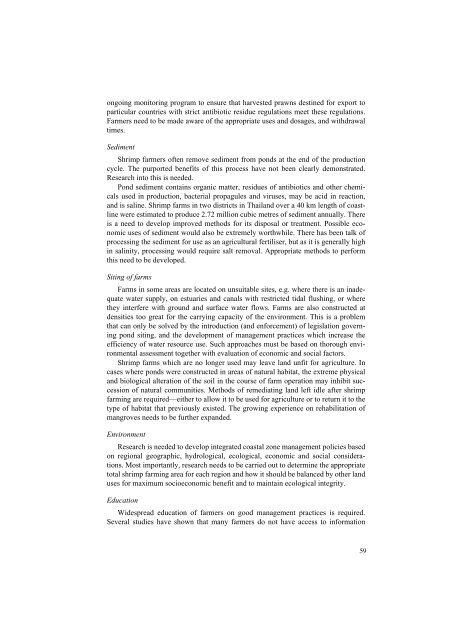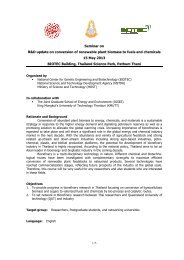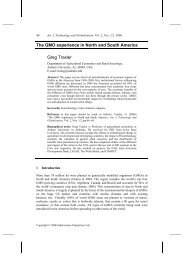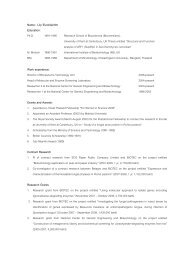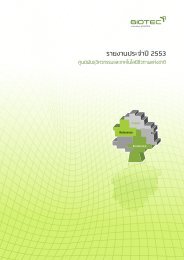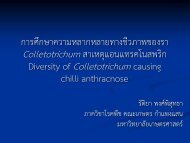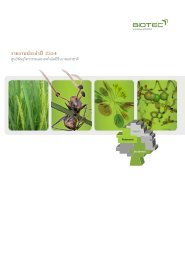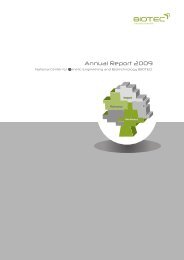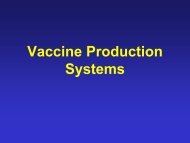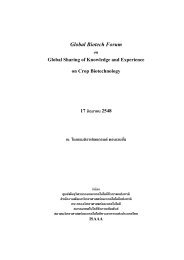Coastal Shrimp Aquaculture in Thailand: Key Issues for Research
Coastal Shrimp Aquaculture in Thailand: Key Issues for Research
Coastal Shrimp Aquaculture in Thailand: Key Issues for Research
You also want an ePaper? Increase the reach of your titles
YUMPU automatically turns print PDFs into web optimized ePapers that Google loves.
ongo<strong>in</strong>g monitor<strong>in</strong>g program to ensure that harvested prawns dest<strong>in</strong>ed <strong>for</strong> export toparticular countries with strict antibiotic residue regulations meet these regulations.Farmers need to be made aware of the appropriate uses and dosages, and withdrawaltimes.Sediment<strong>Shrimp</strong> farmers often remove sediment from ponds at the end of the productioncycle. The purported benefits of this process have not been clearly demonstrated.<strong>Research</strong> <strong>in</strong>to this is needed.Pond sediment conta<strong>in</strong>s organic matter, residues of antibiotics and other chemicalsused <strong>in</strong> production, bacterial propagules and viruses, may be acid <strong>in</strong> reaction,and is sal<strong>in</strong>e. <strong>Shrimp</strong> farms <strong>in</strong> two districts <strong>in</strong> <strong>Thailand</strong> over a 40 km length of coastl<strong>in</strong>ewere estimated to produce 2.72 million cubic metres of sediment annually. Thereis a need to develop improved methods <strong>for</strong> its disposal or treatment. Possible economicuses of sediment would also be extremely worthwhile. There has been talk ofprocess<strong>in</strong>g the sediment <strong>for</strong> use as an agricultural fertiliser, but as it is generally high<strong>in</strong> sal<strong>in</strong>ity, process<strong>in</strong>g would require salt removal. Appropriate methods to per<strong>for</strong>mthis need to be developed.Sit<strong>in</strong>g of farmsFarms <strong>in</strong> some areas are located on unsuitable sites, e.g. where there is an <strong>in</strong>adequatewater supply, on estuaries and canals with restricted tidal flush<strong>in</strong>g, or wherethey <strong>in</strong>terfere with ground and surface water flows. Farms are also constructed atdensities too great <strong>for</strong> the carry<strong>in</strong>g capacity of the environment. This is a problemthat can only be solved by the <strong>in</strong>troduction (and en<strong>for</strong>cement) of legislation govern<strong>in</strong>gpond sit<strong>in</strong>g, and the development of management practices which <strong>in</strong>crease theefficiency of water resource use. Such approaches must be based on thorough environmentalassessment together with evaluation of economic and social factors.<strong>Shrimp</strong> farms which are no longer used may leave land unfit <strong>for</strong> agriculture. Incases where ponds were constructed <strong>in</strong> areas of natural habitat, the extreme physicaland biological alteration of the soil <strong>in</strong> the course of farm operation may <strong>in</strong>hibit successionof natural communities. Methods of remediat<strong>in</strong>g land left idle after shrimpfarm<strong>in</strong>g are required—either to allow it to be used <strong>for</strong> agriculture or to return it to thetype of habitat that previously existed. The grow<strong>in</strong>g experience on rehabilitation ofmangroves needs to be further expanded.Environment<strong>Research</strong> is needed to develop <strong>in</strong>tegrated coastal zone management policies basedon regional geographic, hydrological, ecological, economic and social considerations.Most importantly, research needs to be carried out to determ<strong>in</strong>e the appropriatetotal shrimp farm<strong>in</strong>g area <strong>for</strong> each region and how it should be balanced by other landuses <strong>for</strong> maximum socioeconomic benefit and to ma<strong>in</strong>ta<strong>in</strong> ecological <strong>in</strong>tegrity.EducationWidespread education of farmers on good management practices is required.Several studies have shown that many farmers do not have access to <strong>in</strong><strong>for</strong>mation$(


